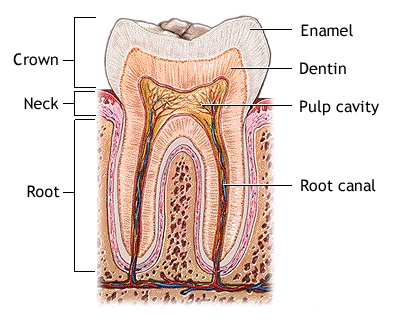
Incisor
The incisors are chisel shaped teeth located anteriorly within the oral cavity. Their name originates from the Latin word ‘incidere’, which means ‘to cut’. Hence, their main function is to cut food during mastication. The incisors are used for cutting and biting.
Canine
The canines tear and shred food. The first baby canines come in between the ages of 16 months and 20 months. The upper canines grow in first, followed by the lower canines.
Lower adult canines emerge in the opposite way. First, the lower canines poke through the gums around age 9, then the upper canines come in at age 11 or 12.
Root
The roots are normally buried in bone, and they serve to anchor the tooth in position. The roots are covered with a thin layer of bone, and they are inserted into sockets in the bone of the jaw. The long, pointed root anchors the tooth firmly in the jawbone.
Permanent tooth
The permanent teeth ate tucked up into the facial bones until they are ready to emerge. Permanent teeth can last a lifetime and it is very important to maintain them to prevent tooth decay developing and damaging them. Tooth decay can be prevented through brushing and flossing daily and attending regular dental checkups
Dentine
Dentine gives shape to the tooth and supports the enamel crown. Its strong, honeycomb structure helps the tooth withstand the powerful squashing force created by our jaws when we bite into food.
Parts of a tooth
The part of a tooth that you can see is the crown. It is coated in enamel – the hardest substance in the body. Beneath is a layer of bone-like tissue called dentine. The pulp cavity at the centre contains the tooth’s blood vessels and nerves.
Premolar
Premolar teeth are between the canine front teeth and the molars. These are transitional teeth; teeth that transition between the tearing function of the canines and the grinding function of the molars. Those grinding teeth only appear in the permanent set.
Molar
This is a permanent molar, which has recently emerged. Like premolars, these crush and grind food. Molars are designed to sustain great amounts of force from chewing, grinding, and clenching, and each molar is anchored to the jaw bone with two to four roots.
Picture Credit : Google
